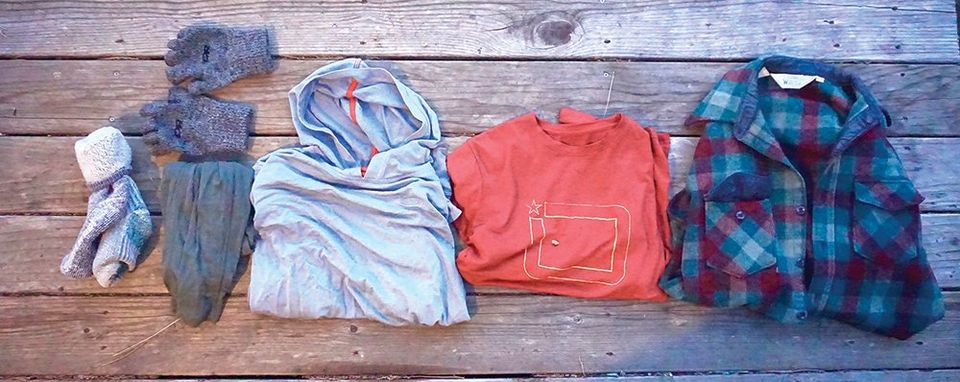Nature's Magic Fibers

One of my earliest memorable pieces of outdoor equipment was an army surplus knitted wool sweater. Military OD green, of course. It was itchy and it was heavy. That sweater though, more than any others, lasted me through years of my youth spent outdoors. It kept me warmer than most anything else could on numerous occasions. In just about every old hunting photo of me, you can see me proudly wearing my torn and worn, green wool sweater.
I was turned on to the benefits of wool at an early age, from exposure to seasoned outdoor folks and an insatiable appetite to read old time adventure stories. Wool, being a natural fiber, has undergone millions of years of adaptation and evolution to hone itself as protective outer layer for animals. It is idolized for its uncanny ability to retain heat even when wet, its seemingly magic ability to resist bacteria and odor and its exceptional breathability. For hundreds of years prior to modern times, wool was the go-to. From Antarctic expeditions, like Ernest Shackleton’s multi-year debacle, to countless early mountaineering ascents, wool clothing was the choice material for superior outdoor performance.
Many outdoor gear companies have been reinventing wool fiber technologies and developing new ways of making garments out of them. Merino wool is one of the biggest new hits in this realm. These wool fibers from New Zealand Merino sheep are coveted for their luxurious softness. While traditional wool fibers are known to be irritating against the skin, proper Merino sheep wool feels softer than even cotton against the skin. The superior “feel” of these Merino fibers, along with the traditional benefits of wool, make Merino wool a choice fiber for modern outdoor activities.
I have found that having many light-to-medium layers of Merino wool gives me the best ability to regulate my temperature. I can wear the same wool layers through wild temperature swings and be comfortable regardless; thanks to, not only its warmth, but its superior breathability when things get a little hot outside. On a typical fall day in the mountains, it can go from sub-freezing temperatures in the sunrise hours, to roasting hot in the high elevation midday sun. With about three or four thin-to-medium packable wool layers, I can remain comfortable all day. While several layers of wool keep me warm in the morning, slowly shedding layers through the day keeps me comfortable. Lightweight, long sleeve wool shirts breathe exceptionally well and protect you from the sun when it gets hot. Traditional thick wool outer layers (such as Pendleton) even do quite an excellent job of shedding water from lighter rainstorms. Thankfully, if it does get soaked, it is not a death sentence if it is cold out. You can take a thick wool outer layer, dunk it in water, wring it out and still feel some insulating benefits. Try that with a cotton sweatshirt.
While technical Merino wool garments can be a little bit spendy, they are, in my opinion, some of the highest performing clothes and best values on the market. Thankfully, heavier traditional wool garments can be found for a fraction of the price. Sources like eBay, thrift stores and other avenues for used clothing often provide options for button-up Pendleton or Woolrich garments for under $50. While these are not as lightweight and soft as Merino wool, they serve as highly durable and effective outer layers for all occasions. If I think I might be fighting through brush, I will always reach for a wool outer layer (as opposed to a fragile down jacket).
From socks to underwear to hats, wool continues to overtake my outdoor gear wardrobe. I was turned on to the benefits of wool at an early age and it continues to impress me with its versatility and utility. It is hard to argue against a fiber refined by nature and tested by generations and generations of rugged explorers. When it comes down to extreme situations, “cotton kills, wool works.”
Qualities and Benefits of Wool Clothing
1. Wool resists wrinkles -- Like a spring, it has a natural shape that it likes, even after being stretched. Its complex coiled structure gives it great resilience against becoming flat and hard.
2. Wool has well-balanced thermal insulation properties -- meaning that it is warm in winter and cool in the summer. Microscopic pores naturally breathe and move responding to changes in humidity levels.
3. Wool is naturally antimicrobial -- It is resistant to bacteria, mold and mildew that can build up on artificial surfaces. The scale-like texture of individual fibers, along with microscopic holes that breathe, make it an unsuitable breeding ground for bacteria.
4. Wool has superior insulative qualities even when wet -- as compared to other fibers. particularly cotton.
5. Easily cleaned -- Wool fabrics clean easily because the outside surface of the wool fiber consists of a series of overlapping scales (similar to the feathers on a bird) which means that dirt sits on the surface of the fiber, making it easy to remove.
6. Wool is naturally flame resistant -- Wool is difficult to ignite, has low flame spread and heat release properties. It does not melt and has superior self-extinguishing qualities.
7. Wool is a naturally renewable fiber -- What could be more natural than wool? Each year, sheep produce a fleece which makes wool a natural and renewable resource that is completely biodegradable. As yet, no one has been able to reproduce the cumulative superior properties of wool synthetically.











